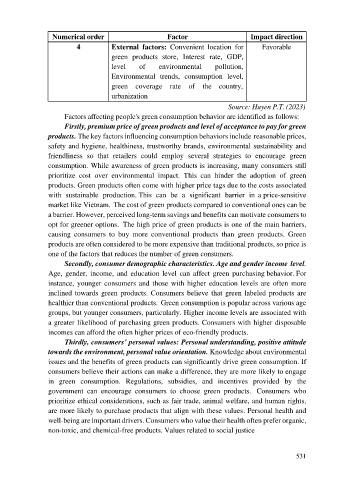Page 539 - Ebook HTKH 2024
P. 539
Numerical order Factor Impact direction
4 External factors: Convenient location for Favorable
green products store, Interest rate, GDP,
level of environmental pollution,
Environmental trends, consumption level,
green coverage rate of the country,
urbanization
Source: Huyen P.T. (2023)
Factors affecting people's green consumption behavior are identified as follows:
Firstly, premium price of green products and level of acceptance to pay for green
products. The key factors influencing consumption behaviors include reasonable prices,
safety and hygiene, healthiness, trustworthy brands, environmental sustainability and
friendliness so that retailers could employ several strategies to encourage green
consumption. While awareness of green products is increasing, many consumers still
prioritize cost over environmental impact. This can hinder the adoption of green
products. Green products often come with higher price tags due to the costs associated
with sustainable production. This can be a significant barrier in a price-sensitive
market like Vietnam. The cost of green products compared to conventional ones can be
a barrier. However, perceived long-term savings and benefits can motivate consumers to
opt for greener options. The high price of green products is one of the main barriers,
causing consumers to buy more conventional products than green products. Green
products are often considered to be more expensive than traditional products, so price is
one of the factors that reduces the number of green consumers.
Secondly, consumer demographic characteristics. Age and gender income level.
Age, gender, income, and education level can affect green purchasing behavior. For
instance, younger consumers and those with higher education levels are often more
inclined towards green products. Consumers believe that green labeled products are
healthier than conventional products. Green consumption is popular across various age
groups, but younger consumers, particularly. Higher income levels are associated with
a greater likelihood of purchasing green products. Consumers with higher disposable
incomes can afford the often higher prices of eco-friendly products.
Thirdly, consumers’ personal values: Personal understanding, positive attitude
towards the environment, personal value orientation. Knowledge about environmental
issues and the benefits of green products can significantly drive green consumption. If
consumers believe their actions can make a difference, they are more likely to engage
in green consumption. Regulations, subsidies, and incentives provided by the
government can encourage consumers to choose green products. Consumers who
prioritize ethical considerations, such as fair trade, animal welfare, and human rights,
are more likely to purchase products that align with these values. Personal health and
well-being are important drivers. Consumers who value their health often prefer organic,
non-toxic, and chemical-free products. Values related to social justice
531

